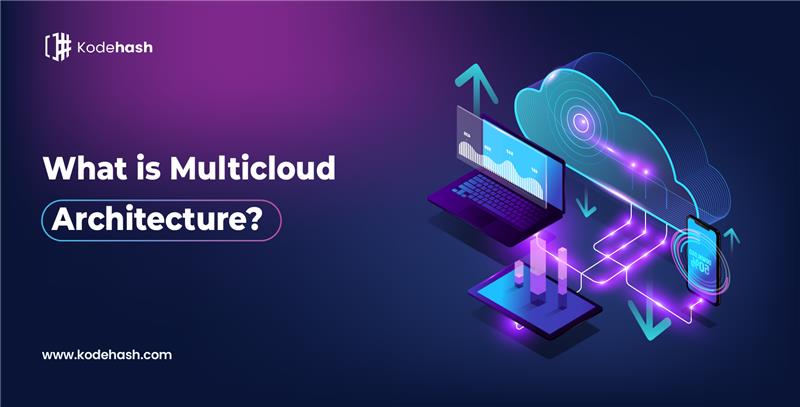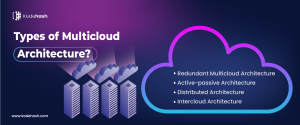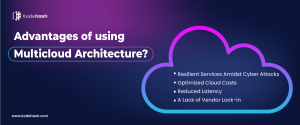What is Multi Cloud Architecture? Definition, Types, Advantages & Security

For using several services to complete different operational needs, businesses choose multi cloud architecture. Through the setup, the availability of varied systems can be managed better. This indicates the main function of this cloud architecture. There are various kinds of this setup, inclusive of distributed, intercloud, and active-passive. They can influence the processes of organizations in several ways. Based on the type, a user can expect certain benefits. It can make their services secure against cyber threats. It is vital for optimizing the prices of the cloud. In addition to this, the overall setup is secure as well as reliable.
What is Cloud Architecture?
In order to build the cloud, cloud architecture is an important element put into use. This element indicates the layout. Further, every essential component as well as technology that is needed for cloud computing is connected by it.
- In other words, this type of architecture can be understood as a blueprint.
- It clarifies how several technologies will be synchronized for the formation of the cloud environment.
- With the help of this, an online or virtual platform is built. Through this platform, applications can work.
What does Multi Cloud Architecture Mean?
Multi Cloud architecture hints at a strategy for cloud computing. It can also be understood as an important IT system. It is inclusive of not one but multiple clouds. They can be public as well as private. Also, they can be networked, at times, as required.
How does Multi Cloud Architecture Work?
In a multi cloud architecture, a setup is involved wherein different services are used. These services are for certain operational needs. Through this setup, the availability of a particular system is improved. It helps to ensure a better performance. Such a performance is achieved when the workloads are balanced across numerous cloud-based environments.
- Via this architecture type, users can access a number of platforms for:
- Networking,
- Storage,
- And, applications.
What are the Types of Multi Cloud Architecture?

With a multi cloud architecture, different public clouds are used at the same time. The uses can occur in varying forms. This can be understood by looking at the types of this architecture. Primarily, three of these are the most important. They include redundant, intercloud, and distributed architecture.
Redundant Multi Cloud Architecture
A redundant multi cloud architecture is linked to the hosting of at least 2 instances of one application via varied providers for procedures like failovers. Even for the management of an app’s performance, this architecture is of use. Keep in mind that it can help host more than 2 instances as well. When deployed, it can be active-passive or active-active.
When the model is active-active multi cloud, a service/app is used over 2 or multiple cloud vendors. They are live as well as comprise one load balancer for the operation of an app. Even to manage its traffic, the model is reliable. Note that when there are failures at the end of the cloud provider, then using the other service, the traffic gets directed quite automatically.
Active-passive Architecture
Given that the model is active-passive multi cloud, a service or application gets utilized via a specific vendor of cloud. The backup of this service/app gets deployed through another provider. Note that it will be used when the prior one undergoes any failure. This failure can comprise a crashed server. When it occurs, the backup will be used for routing the traffic. This is an automatic process.
Distributed Architecture
With a distributed architecture or configuration, apps and services are allocated by businesses. Through the providers of the cloud, this is attained. Thus, the vendors of the cloud can be selected as per the workload and relevance.
Intercloud Architecture
The third type of multi cloud is intercloud architecture. In this configuration, data and the workflow of analytics can move between public clouds. Since the movement of data is seamless, it is referred to as intercloud.
- For this, integrating 2 services is important.
- Their synchronization is like a cloud environment that is hybrid.
- In this, multiple clouds are linked.
- These are inclusive of both private and public clouds.
Advantages of Using Multicloud Architecture for Business

One of the benefits of using multi cloud architecture is that it assists in the management of data. Varying kinds of data can be generated through it. The database may need cold storage. It may not be frequently accessed as compared to hot storage. Thus, putting all the information into a single cloud may not be needed.
With multi cloud, beyond managing data, there are 4 additional benefits to observe too.
Resilient Services Amidst Cyber Attacks
Certain businesses may only rely on a particular cloud platform for managing their resources. In case a cyber attack takes place, it may affect every operation, even for a long period of time. Following this, end users may not be able to access those operations.
Assuming that a business invests in multi cloud architecture, its services can become resilient when cyber attacks occur, irrespective of their type. This is due to the availability of additional clouds that help in managing the workload.
Optimized Cloud Costs
Prior to using multicloud, a business should analyze the performance of its workloads. These workloads are either in the cloud or on-premises. As a consequence of the same, it can go through the options to meet its needs regarding workload performance cost-effectively. Since multicloud can be price-worthy, it will be beneficial to opt for it.
Reduced Latency
The users of an app can be distributed globally. The data can be transferred via an individual data center. However, this can cause others to witness a poor response time. Delays can arise if the data traffic requires traveling through different nodes, prior to being received by the end-user. This delay can be understood as latency. It is part of such cloud services.
When utilizing multi-cloud, a data center can be deployed for several areas by a cloud architect. The one that is nearest to a user may render the information requested. And, there can be low server-related hops. For international businesses, this benefit is significant. This is because it can aid in serving the data geographically.
A Lack of Vendor Lock-in
With multicloud architecture, challenges like vendor lock-in can be prevented. Companies can choose the top or desired services via all the cloud platforms. This will result in the formation of a customized infrastructure. It will serve the best interests of those companies.
Businesses using multicloud may not have to manage different processes as per the setup of a particular provider. They can go through the services of varied providers. Then, depending on their operations or processes, the best one can be selected.
Is a Multi Cloud Architecture Safe?
A multi cloud architecture can be considered safe. It is utilized as it is secure in addition to being reliable. Since this aspect is ensured, one is not required to depend on a single vendor or service provider. As multicloud is safe, when a particular vendor undergoes failures, the service can be accessed through a different provider.
Kodehash: For Reliable Multi Cloud Architecture Services
For reliable as well as secure multi cloud architecture, Kodehash is among the top providers. As a leading company for this service, it can be trusted, especially for the best types and benefits. Besides, it can ensure cost-effective cloud architecture solutions for businesses.
As a Final Observation
Cloud and multi cloud architecture are useful services for businesses. They can meet their operational needs through these. Also, they can choose between the best types to fulfill their requirements in the best ways. Depending on the type preferred, they can expect benefits ranging from cost-effectiveness to minimal latency.
Recent Blogs
Subscribe:
Subscribe for the newsletter and receive email notification of every future post.




